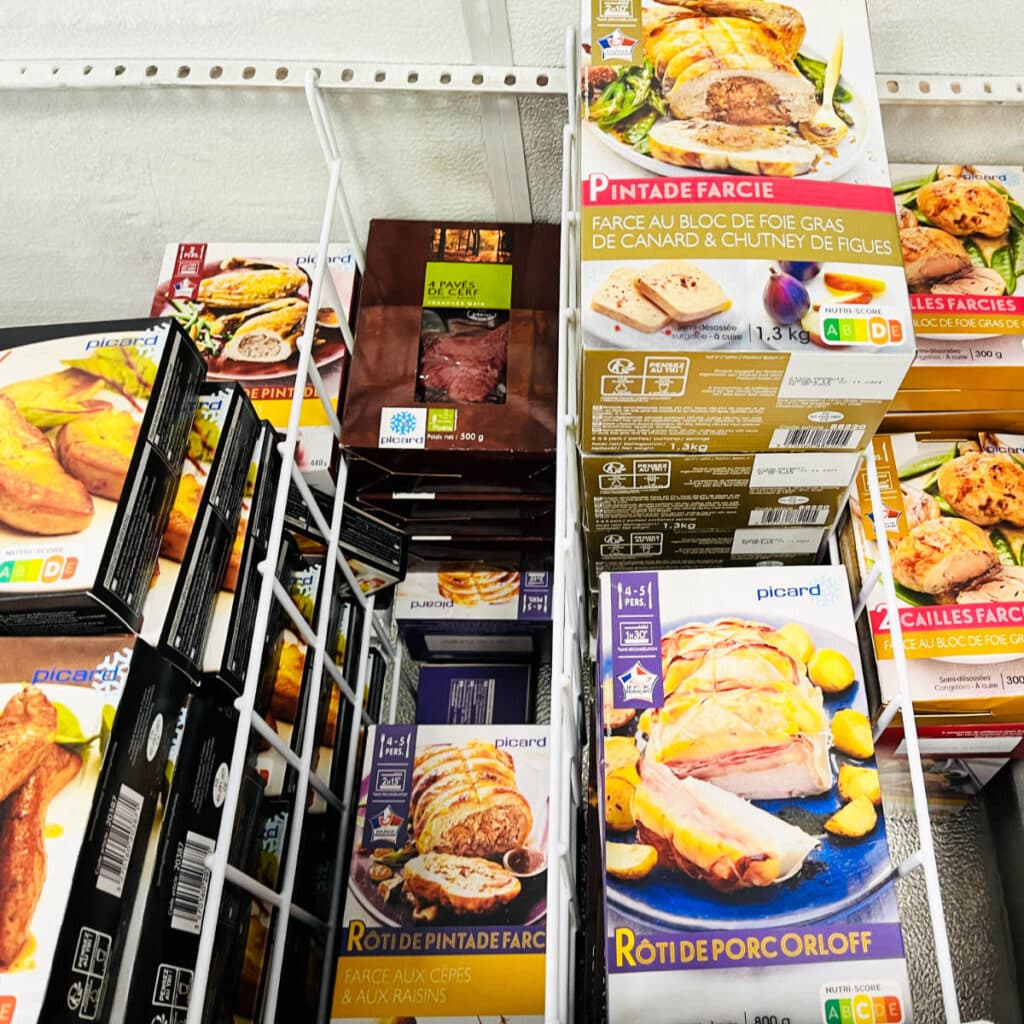There is no better way to get to know how the French live than to visit a grocery store in France. From épiceries (convenience stores) to supermarchés (supermarkets), it can be a rather head-scratching experience. And that is even if you speak French!
As someone who has lived in Paris for over 10 years, I can tell you that from cultural practices to local regulations, French grocery stores offer a distinct shopping experience. And that too varies from one supermarket to another.
So whether you are planning a picnic, an apéro, or just an ordinary weeknight dinner, let’s get to my top tips for grocery shopping in France, shall we? Allons-y!
Large supermarket chains
First off, you may have seen them everywhere as you wander around France, the grand supermarché.
If you don’t want to head to the boulangerie (bakery), boucherie (butcher), fromagerie (cheese shop), marché des legumes (vegetable market), poissonniere (fish shop), etc. you will want to head to one of these large supermarkets or hypermarkets.

The largest and most popular supermarkets in France are:
- Auchan – large supermarkets, usually in the city outskirts. Often sell everything from food and alcohol to clothing and electronic equipment.
- Carrefour – large supermarkets, but also have more smaller grocery stores that are in city centers called “Carrefour city”, “Carrefour Express”, “8 à Huit”, and “Proxi”. One of the world’s largest grocery chains, competing with Auchan.
- Monoprix – a high-end supermarket, which is smaller than Carrefour or Auchan and has slightly higher prices. Monoprix has formed a partnership with Amazon.com, similar to Whole Foods in the USA, and is even popular for its clothing shopping.
- Franprix – smaller grocery chain, usually in city centers.
- Leclerc – large supermarkets with good prices but not usually in city centers like Paris. Leclercs are often only accessible by car, but have the largest food markets in France.
- Intermarché – similar to Carrefour with large hypermarkets in city outskirts and smaller “express” grocery stores in centre-villes.
- Casino and Spar – similar to Auchan, large supermarkets in the outskirts and smaller shops in city centers.
- Super U supermarkets – several brands under the name Super U, Hyper U, and the smaller U Express stores.
Frozen foods stores
As large as French supermarkets are, they do not have the same range of frozen foods as one might like.

With everything from French sauces, soups, appetizers, and other prepared dishes, as well as raw ingredients, frozen food shops are very popular in France:
- Picard – a very popular frozen food shop that can be found in just about every small town and neighborhood in France.
- Thiriet – a newer frozen food shop that is trying to compete with Picard.
Discount supermarkets
If you are watching your wallet and looking for a discount alternative in France, here are the supermarkets to head to:
- Aldi – large chain that took over the Leaderprice discount chain from Casino.
- Lidl – slightly higher prices, positioned between Aldi and Carrefour.
Organic, bio and specialty markets
For organic foods and products, you will want to head to these bio supermarkets:
- Naturalia – a specialty shop from Monoprix with organic fruits, vegetables, cereals, dairy products, etc.
- Bio c’ Bon – specializing in organic fruits and vegetables.
- Biocoop – a biofoods cooperative from local farmers and producers that has a network of independent shops.
- Naturéo – smaller network of organic supermarkets.
French grocery stores that deliver
In cities and larger towns in France, grocery delivery services have gained popularity in recent years. With busy lifestyles and the convenience of online shopping, many people opt for having their groceries delivered.

You can go online and create an account and have your items delivered to your doorstep. Prices are slightly higher than in person, and there can be a delivery fee depending on how much you order.
Along with delivery, you can also order online and use the “Drive” where you come and pick up your items. Some of the most popular grocery shops for delivery are:
- Monoprix and Amazon – partnership to get almost anything delivered to your door.
- Carrefour – wide range of delivery and pickup options across the country with better prices than Monoprix.
- Auchan – similar to Carrefour.
- Picard – frozen food shop offering delivery and drive.
- Houra – a bit more expensive than Carrefour or Auchan, but good delivery.
- Mon marche – regular and organic fruits and vegetables delivered to your doorstep.
- Leclerc – good prices but limited delivery depending on where you live.
- Intermarché – both delivery and pickup “drive” options
Tips for French grocery stores and supermarkets
Now before you head over to your local grocery store in France, you may want to read a few tips. It isn’t quite like you may be used to, believe me I know!
1. Check opening hours
One of the most important things to note when visiting a grocery store or supermarket in France is to check their opening hours.
Unlike some countries where supermarkets are open 24/7, French stores much more restricted operating hours. Opening times vary depending on the size and location of the store, with some supermarkets closing as early as 8 p.m. on weekdays and being completely closed on Sundays.
I would highly advise you to plan your shopping accordingly and check the opening hours in advance!
2. Bring your own bags.
In recent years, France has introduced a law to ban excessive plastic and promote sustainability. As a result, you are required to bring your own bags to the grocery stores or purchase a new one.
Plastic bags are no longer freely provided at checkout counters, and customers are encouraged to bring their own tote bags or reusable shopping bags. Most supermarkets usually provide sturdy bags near the checkout counters for customers to purchase.
3. A 6-pack can be opened and sold individually.
In French grocery stores, it is common to find packaged items, such as beverages on display in bulk. You are actually allowed to open a 6-pack of milk and just buy one however.
This allows customers the freedom to purchase single items rather than being constrained by pre-packaged quantities. So, if you only need one can of soda or a single yogurt, you are free to do so.
4. No medication aisles (although there may be a parapharmacy).
Unlike some countries where over-the-counter medications are readily available in grocery stores, medication is not legally allowed to be sold in supermarkets in France.
You may be able to find some health and wellness products like bandaids and organic products in the “parapharmacy section”, but for anything more you will have to head to an actual pharmacy.
5. No alcohol sales on Sundays.
In France, there are a lot of regulations governing the sale of alcohol. One notable restriction is the prohibition of alcohol sales on Sundays in most stores.

This rule is rooted in French christian traditions and aims to preserve the reverence for Sundays as a day of rest and family time. So if you are having a big Sunday lunch, it’s important to plan your shopping accordingly in advance.
6. Milk and eggs are stored at room temperature.
In French grocery stores you will find that milk and eggs are typically displayed at room temperature on a shelf, rather than being refrigerated. This is because milk is pasteurized at higher temperatures than in North America, and so does not need refrigerating.
For the eggs, European regulations and food handling practices ensure they are safe to consume even when not refrigerated. While it may seem unusual at first, rest assured that these products are perfectly safe to use.
In case you were wondering, pasteurization was developed by French scientist, Louis Pasteur, who incidentally has several streets named after him. You can read more French food facts here.
7. Eggs are brown, not white
And speaking of eggs, eggs are brown in France not white. The color of the eggs depends on the genetics of the chicken and in the U.S., it is the “leghorn” breed being used, which gives white eggs.

Never fear though, the shell color doesn’t change the flavor of the eggs, or their nutritional value. You can read about more items from a classic French pantry here.
8. Head to the “foreign foods” aisles.
If you are looking for American-style peanut butter or British-style scones, you will not find these in your regular French grocery aisle. Instead you will have to head to the foreign foods section to find your favorite delicacies from back home.
9. Check out the regional section.
Depending on where in France you live, you will also find different regional products on your local grocery shelf. From truffle jams in Occitanie, olive oil in Provence and cider from Brittany, you will find many regional specialities depending on where you are.

If you are looking for souvenirs to take home from France, it is much more cost-effective to pick up a few items from a French supermarket than one of the souvenir shops.
10. Bag your own groceries.
In French grocery stores, customers are typically responsible for bagging their own groceries. Unlike in some countries where store employees bag the items for you, in France it is customary to pack your own purchases.
These days most supermarkets in France also use self-checkout. There is often an option on screen to complete your transaction in English, if you don’t speak French.
11. No helpers to bring the groceries to your car.
In France, you won’t find helpers or baggers to assist you in carrying your groceries to your car. Once you have completed your purchase and packed your bags, you are responsible for transporting them to your vehicle.
This self-reliant approach may initially seem different for those accustomed to having assistance, but unfortunately there is no help for it.
12. Bring your own shopping caddy or trolley.
If you are buying a lot of groceries and don’t have a car, it is common to come to the grocery store in France with your own shopping cart or trolley. Known as “caddies” in French, they are available for purchase in all large hypermarkets and hardware shops.

These carts offer a convenient way to navigate the store, especially when you have a larger shopping list. (In smaller shops, you will typically see French people leave their caddy at the entrance and then pick it up at the end as they pay.)
13. Buy in store and get your groceries delivered.
If you live near a Monoprix, you may want to look into home delivery. Unlike many other grocery stores in France, Monoprix offers to let you shop in-store and choose your products as you normally would.
Then rather than carrying your groceries home, they will deliver it to your residence within 2 to 3 hours from checkout. You can also choose a one-hour slot for delivery, the same day or the next day.

So the next time you visit a grocery store or supermarket in France, go ahead and explore the aisles. If you enjoyed that article, you may like to read more about exploring the French marché. A bientôt!




